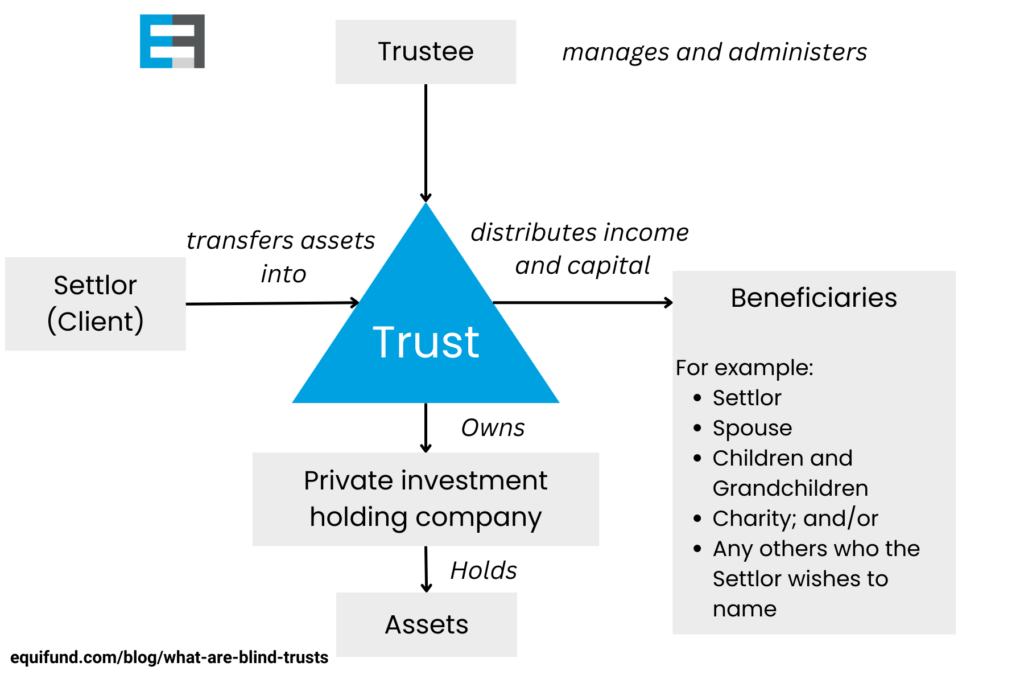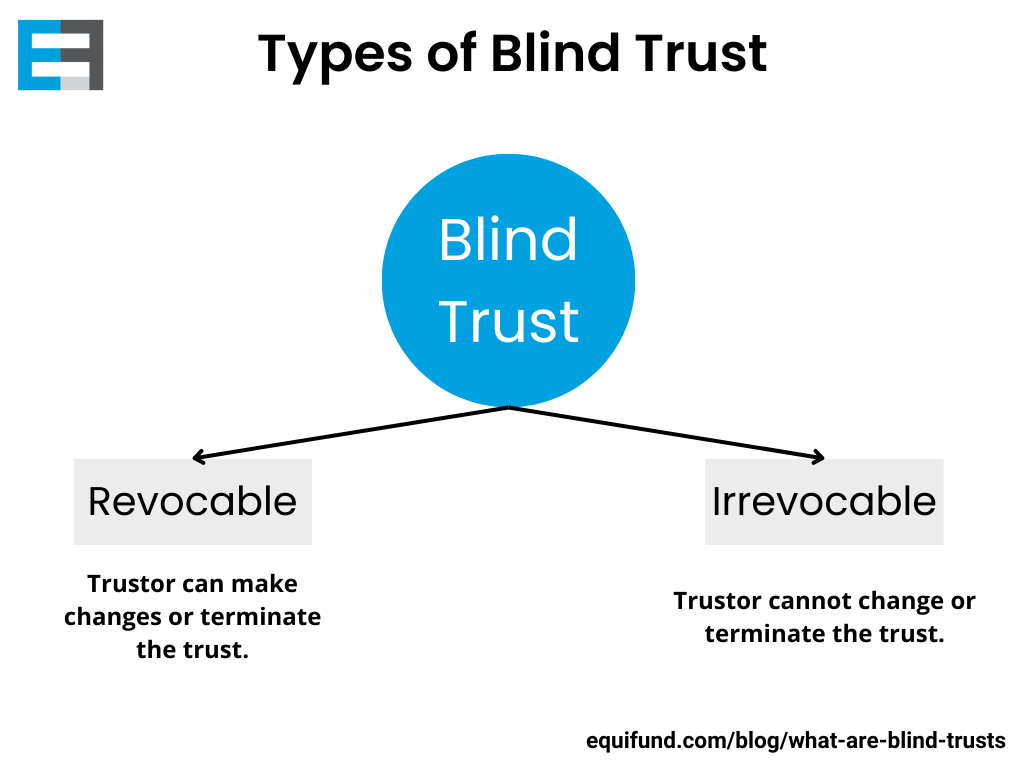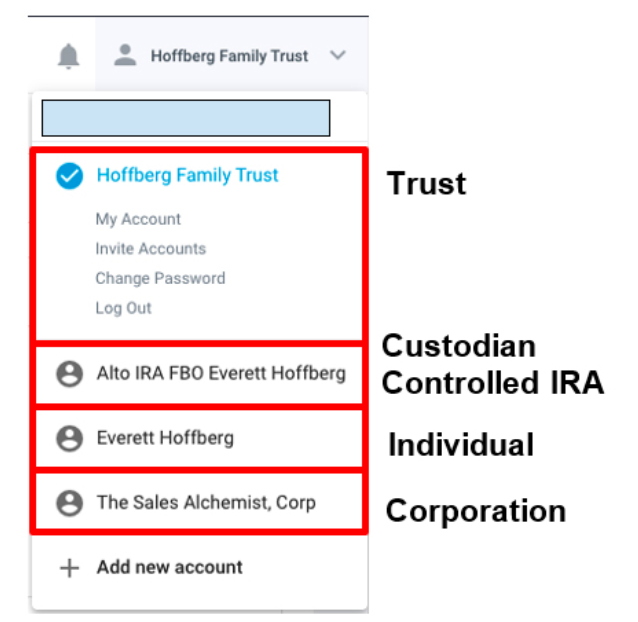For families interested in protecting their assets, reducing or avoiding the estate tax entirely, and otherwise building generational wealth, trusts have long been the vehicle of choice for the world’s wealthiest families.
But the power of trusts isn’t limited to the ultra wealthy. Everyday families can make use of something called blind trusts to not only pass on their wealth, but set an expectation of how that wealth will be managed (and protected) for generations to come.
Today, we reveal what a blind trust is, how it works, and how you can set one up for yourself.
Key Takeaways:
- Estate Planning: A retired business leader can establish a blind trust to plan for the seamless transfer of his assets to future generations
- Mitigating Conflicts of Interest: A blind trust is a powerful financial tool that public figures often utilize to mitigate conflicts of interest between their personal investments and professional roles.
- Trustee Discretion: Once the grantor has set up the trust and assets are transferred, the grantor no longer has control over or knowledge of the specific assets held in the trust.
- Asset Protection: Protecting assets from creditors and liabilities.
Understanding Trust Terms
Before we dive into the complex world of blind trusts, let’s define a few key terms.
Grantor or Trustor: The person or entity who establishes a blind trust. They are the ones who transfer their assets into the trust, relinquishing control and ownership.
Trustee: The party responsible for managing the blind trust’s assets and making investment decisions on behalf of the grantor. This can be an individual or a financial institution with the necessary expertise and fiduciary duty to act in the best financial interests of the grantor and the beneficiaries.
Grantee or Beneficiary: The individual or organization designated to receive the assets or distributions from the blind trust. They have a beneficial interest in the trust, but do not have control over its management. In some cases, the beneficiary can be the same person as the trustor. But in other cases, the beneficiary is one of the trustor’s loved ones.

What is a Blind Trust?
A blind trust is a powerful financial tool that individuals, including business leaders and government officials, often utilize to mitigate any conflict of interest between their personal investments and professional roles.
In brief, it’s a trust established where the owner, known as the trustor, relinquishes full control and management of the trust’s assets to an independent party called the trustee. The trustee is entrusted with the authority to handle the assets and make investment decisions without the trustor’s knowledge or consent, hence the term “blind.”

The trustee’s role is crucial in maintaining privacy and preventing real or perceived conflicts, ensuring that the trustor remains uninformed about the trust’s holdings and the impact of their official actions on their private interests. Blind trusts can also be sub-categorized as either a revocable trust or an irrevocable trust. The main difference being whether or not the trustor’s can make changes to the trust.
Overall, blind trusts empower individuals to separate their wealth from their decision-making, fostering transparency and integrity in both personal and professional realms.
Here’s a table that shows you the rules around blind trusts in each U.S. state. It also covers D.C., the Virgin Islands, Guam, and Puerto Rico.
What is the difference between a trust and a blind trust?
The primary distinction between a trust and a blind trust lies in the level of information and control accessible to the trustor and beneficiary.
A trust is a legal arrangement where the trustor (the wealthy individual creating the trust) places financial holdings under the control of a trustee for the benefit of a beneficiary. In a regular trust, the trustor maintains control over the assets and can make decisions regarding how they are invested and distributed to the beneficiary. The beneficiary is also aware of the assets within the trust.
A blind trust, on the other hand, operates differently. In this type of trust, the trustor and beneficiary do not have access to or knowledge of the trust’s investment holdings.
In this fiduciary relationship, the trustee has complete control over managing the investments, and the trustor and beneficiary have no say in this matter whatsoever.
The lack of transparency in a blind trust is deliberately designed to prevent any conflict of interest and maintain the privacy of the trust’s assets. A corporate executive, for example, can place shares of their company’s stock in a blind trust to avoid insider trading accusations.

So while a trust offers control and transparency, allowing the trustor to make decisions about asset management, a blind trust restricts access and knowledge, giving full control to the trustee to prevent conflicts of interest and safeguard the privacy of the trust’s assets.
Reasons to Establish a Blind Trust
Overall, blind trusts provide a strategic solution for individuals seeking to separate their personal investments from their professional obligations.
By entrusting an independent trustee with full control over assets and investments, trustors can avoid potential conflicts of interest with greater transparency, while enjoying privacy and the freedom to focus on their responsibilities without undue influence.
Let’s break down the key benefits of a blind trust:
Asset Protection
By placing assets into a blind trust, individuals can shield themselves from potential conflicts of interest that may arise due to their employment or public office. For example, a legislator could establish a blind trust to separate their personal financial interests from their official actions, ensuring impartial decision-making.
Trustee Discretion
In a blind trust, the trustee enjoys complete discretion over managing the trust assets and any income generated within the trust. They can buy, sell, or modify investments without needing to disclose these transactions to the trustor, thereby reducing the risk of bias or favoritism.
Impartiality
A crucial element of a blind trust is the appointment of an independent trustee who does not have a close personal relationship with the trustor. This impartial third party ensures that the trust operates objectively and avoids conflicts of interest.
Privacy
Blind trusts offer a high level of privacy since the trustor has no knowledge of the trust’s contents or the trustee’s investment decisions. This confidentiality helps protect the trustor’s financial information and prevents potential external influences on decision-making.
Flexibility
Blind trusts can be either revocable or irrevocable. A revocable trust allows the trustor to make changes or terminate the trust if circumstances change, while an irrevocable trust provides a more permanent structure for asset management.
One benefit of the latter is that irrevocable trusts are not taxed as an asset, meaning it can be leveraged to reduce tax liability. Another tax reduction tool savvy investors use is a self-directed IRA LLC.
While you don’t have direct control over a blind trust, you can still structure in a way where it allocates capital according to your wishes. For example, you can instruct your trust to give conditional gifts (i.e. I give a car to my son once he passed his driver’s exam).
Examples of Who Uses Blind Trusts
Setting up a blind trust can serve various purposes, primarily aimed at avoiding conflicts of interest and maintaining objectivity in specific positions or situations. Here are a few examples of the types of individuals who opt for blind trusts.
Corporate Executive
Blind trusts are frequently used by corporate executives or board members. Those who hold substantial shares in the company and have access to privileged information may find trading restrictions a hindrance to effectively managing their investment portfolio. Such regulations can be sidestepped if the executive’s assets are moved into a blind trust.
Retired Businessman
Consider a retired businessman who has a desire to pass on his wealth to future generations or charitable causes. Establishing a blind trust allows him to plan for the seamless transfer of assets without any disruptions. The trust can outline specific instructions for the management and distribution of the trust assets, ensuring a smooth transition and potentially providing financial security for his heirs or philanthropic endeavors.
Public Servants
Public servants, such as government officials, may utilize blind trusts to manage private sector assets owned by themselves, their spouses, and dependent children. This practice becomes essential when their involvement in legislation or decision-making could potentially impact their investments. Placing assets in a blind trust, particularly an irrevocable one, ensures that these elected officials can act impartially and avoid public scrutiny around their holdings.
Religious Figures
Religious individuals may employ blind trusts to handle assets received from their parishioners. By utilizing a blind trust, they can maintain privacy and conceal the specific assets they receive, ensuring transparency and avoiding conflicts of interest within their religious duties.
Wealthy Individuals with Sudden Windfalls
Individuals who unexpectedly come into large sums of money, such as inheritances, lottery winnings, or gambling proceeds, may choose to establish a blind trust for privacy and conflict avoidance.
How Does a Blind Trust Work?
At a high level, a blind trust is a legal arrangement in which a person places their assets or investments under the control of a trustee.
Once the grantor has set up the trust and assets are transferred, the grantor no longer has control over or knowledge of the specific assets held in the trust. From here on out, the trustee manages the assets held in the blind trust. The trustee has the authority to make investment decisions, buy or sell assets, and take other actions in accordance with the trust agreement.
The grantor typically provides general guidelines regarding investment strategies but does not have involvement in day-to-day investment decisions.
And while the grantor remains unaware of the trust’s specific activities, they may receive periodic reports from the trustee that disclose the trust’s overall performance, such as financial statements or summaries. These reports typically provide aggregate information without disclosing individual holdings.
How to Set Up a Blind Trust?
In the realm of financial planning and asset management, a blind trust stands as a unique and distinct entity—offering a heightened level of confidentiality and hands-off management. Let’s break down the process of setting up and running a blind trust.

Step 1. Establishing the Trust
The trustor, also known as the originator, initiates the process of setting up a blind trust. They work with an experienced lawyer to draft the necessary legal documents for the trust, including the trust instrument. The trustor may specify the beneficiaries and outline investment goals during this stage.
A blind trust can be either revocable or irrevocable, depending on the trustor’s goals. A revocable trust allows the trustor to make changes to the trust, including modifying beneficiaries or replacing the trustee. In contrast, an irrevocable trust cannot be changed once established and provides additional asset protection, making it harder for creditors or government entities to claim the assets.
Step 2. Appointing a Trustee
The trustor selects a trustee who will act as the fiduciary and manage the blind trust. It is crucial to choose a trustee who is both trustworthy and knowledgeable in investments. It is recommended to select someone independent, without a close personal relationship, such as a friend or relative, to avoid conflicts of interest.
Step 3. Transferring Assets
The trustor transfers assets, such as funds, equities, bonds, or real estate, into the blind trust. These assets become part of the trust property, and the trustor no longer has direct control over them.
Step 4. Finalizing the Trust
Once the trust is established and assets are transferred, the trustor signs the necessary documents, completing the formation of the blind trust. At this point, the trustor and beneficiaries lose any authority to manage or make decisions regarding the trust’s assets.
Step 5. Trustee Takes Over
The trustee assumes full control and responsibility for managing the blind trust’s investments. They have the full discretion to make decisions about buying, selling, or trading securities within the trust. The trustor and beneficiaries have no involvement or knowledge of these investment activities.
Step 6. Limited Communication
Following the establishment of the blind trust, there is no further communication between the trustor, beneficiaries, and the trustee regarding asset management. The trustee operates independently, ensuring that the trust’s assets are handled in accordance with the trust agreement and applicable laws.
The exact details and requirements of a blind trust can vary depending on jurisdiction and specific circumstances, so it is important to consult with legal professionals familiar with applicable laws when setting up such a trust.
Conclusion
With a blind trust, you can effectively manage your wealth while ensuring transparency and protecting your reputation.
Whether you’re a high-profile politician or a lottery winner, a blind trust offers numerous benefits. It establishes a layer of separation that helps eliminate any real or potential conflict of interest and shields you from accusations of wrongdoing. Additionally, it allows individuals who plan to pass their wealth onto future generations to maintain their financial privacy.
At Equifund, we allow you to invest in Private Market deals using your Trusts. To set that up, we must first verify the Trust is in good standing by requesting the following documents:
- Trust Agreement (or Trust Deed): This is an estate planning document that allows you to transfer ownership of your assets to a third party.
- Proof of address: Must be dated within the last 90 days (i.e. bank statement).
For a full walk through of how to invest in Equifund deals using your Trust, go here.





